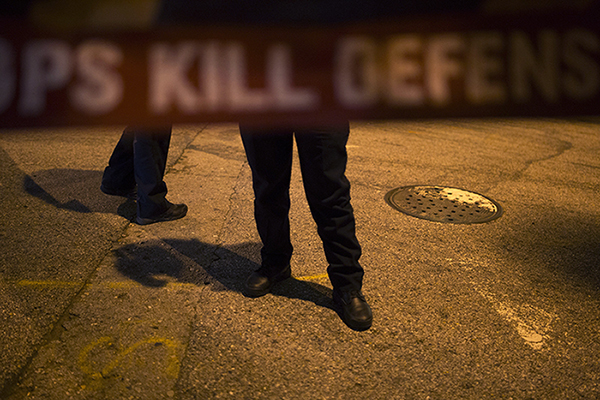
In the first episode of The New York Times’ “The Daily” podcast entitled “Baltimore After Freddie Gray,” one would expect it to be another run-of-the-mill outsider point-of-view of 2015’s Uprising following Gray’s death while in police custody. But the Times isn’t your typical publication. Reporter Sabrina Tavernise takes a deeper dive into why instances of police corruption even happen in the first place.
Surprisingly, the episode doesn’t begin with the recounting of Gray’s death and arrest, but instead Tavernise begins explaining why Gray’s arrest served as the catalyst for the increase in homicides and violence in Baltimore. Through the lens of Toby Douglas and Davetta Parker, the mother and grandmother of Lavar “Nook” Douglas who was shot and killed by police in 2016, Tavernise tells the story of how Baltimore has landed in the national discussion of race and policing. The five-part series—that was released over five days beginning June 3—discusses everything from the spiking homicide rate to the investigation into the Gun Trace Task Force.
Lavar “Nook” Douglas’s case is the centerpiece of the series.
Very reminiscent of the popular Baltimore-based podcast “Serial” that followed the case of Adnan Syed whose case was reopened because of the media attention, Douglas’s family is hoping for similar results. Nook, who was 18 at the time, was killed by a Coppin State police officer near the campus after opening fire at a car in the middle of the street. Almost three years later, the family is still requesting that the BPD to identify the officer.
Tavernise and her producer, Lynsea Garrison, spent four months with his family to help them investigate the death in order to answer a deeper question about the violence in Baltimore: “How did things get like this?”
“The cops definitely pulled back,” retired Deputy Commissioner of Operations for BPD Tony Barksdale says. “Nobody wanted to be the next cop that makes an arrest and the arrest goes wrong.”
Former Police Commissioner Darryl De Sousa added: “Criminals got emboldened . . . they just tried to take advantage of a storm that was going on.”
Zero-tolerance policing is identified as one of the causes.
“What every black in Baltimore City knows is that the Baltimore City Police Department is the most racist and corrupt organization out here,” Sgt. Louis Hopson says. “You don’t get that way overnight. Freddie Gray was just a flash point, you see. And the problem is, no one trusts us now. How can you do your job if you don’t have the community’s trust.”
“The Daily” explores corrupt policing in Baltimore and points to the mayoral race of 1999 when Martin O’Malley introduced the idea of zero-tolerance policing in Baltimore that he’d witnessed in its infancy in New York City. The idea seemed like a good one at the time, but officers like Hopson disagreed with the new initiative.
“I appealed to Martin myself and said, ‘Martin, listen, if you bring zero tolerance here, in four or five years from now,’ I said, ‘It’s going to be so unbelievable,’” Hopson says. “‘You’re going to have corrupt police officers right and left. You can’t give this kind of authority to a police department and just say, ‘Look, you guys go do what you want’—not without some type of, you know, checks and balances on everything. Well, they did.”
The Gun Trace Task Force (GTTF) put the Baltimore Police Department in the hot seat. . . again.
The plain-clothes unit that was created at the peak of zero-tolerance policing has been under fire since it was discovered that the officers had been stealing from residents for years. Two of the eight officers—former Sgt. Wayne Jenkins and former detective Marcus Taylor—were sentenced to 25 years and 18 years, respectively, for a wide range of crimes including stealing drugs, money, and fabricating evidence. This has forced the city to re-examine nearly 1,700 cases involving the GTTF. “The Daily” includes audio from the body cameras of the GTTF officers as they are plotting to steal from a suspect they’ve apprehended.
“Everybody knew how corrupt the task force was,” Hopson says. “Any rotten fruit amongst good fruit, pretty soon all the fruit rots. That’s what you have here. I’d say 50 percent of them are bad and that’s no good.”
There is no given solution to the race and policing problems facing Baltimore.
While Tavernise spoke with everyone from gang members and drug dealers to former police officers and a grieving family, her exploration into Baltimore’s corrupt policing, past and present, provided nothing more than an analysis of the situation that residents are living every day. The general consensus of the those that were interviewed was that, in order to make Baltimore a better and safer city, the BPD needs to be completely wiped and revamped.
“We’ve got to understand that, while you can become a police officer at the age of 21, there’s no other position in the country that allows you to remove another human being from existence solely based on your title and training—not even the military has that power,” former FBI agent and advisor to BPD Tyrone Powers says. “We have to make sure they are doing this right. We have to get it right so there isn’t another situation like Freddie Gray. If we don’t get better, Baltimore will burn and so will other cities like it.”
